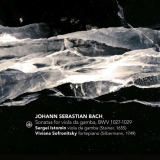Die beiden Interpreten dieser Aufnahme der Gambensonaten von Johann Sebastian Bach wagen sozusagen einen kleinen Spagat. Denn einerseits ist die Gambe – das Instrument stammt von Jakob Stainer – zu den Zeiten von Bach eines, das schon eher als Auslaufmodell betrachtet werden kann. Andererseits ist das Fortepiano ein junges Instrument, das erst noch im Begriff war, das Cembalo abzulösen. So ist der hier gespielte Nachbau eines Instrumentes von Gottfried Silbermann, das im letzten Lebensjahr von Bach entstand.
Gleichwohl erzielen die Interpreten damit eine reizvolle und gelungene Neuausrichtung, wenn auch die Werke noch für das Cembalo geschrieben waren. Der Klang eines Cembalos, der sicherlich heutzutage auch nicht mehr so piepsend anstrengend ist, wird abgelöst durch das Fortepiano und damit einen anderen Charakter, der aber noch nah bleibt und auch nicht so dominant und andersartig wird, wie es beim Klavier der Fall wäre.
Istomin beherrscht nicht nur das Spiel auf dem Cello, sondern auch auf der Viola da Gamba. Vom Stil her kann man ganz verleugnen, dass er einen klingenden Ansatz sucht, der eher in eine galante oder gar romantische Richtung deutet, als die historisch informierte Spielweise zu pointieren. Zusammen mit Viviana Sofrinitsky erkundet er solistisch spritzige Tempi, ohne es zu übertreiben. Trotzdem wirken einige Momente verhuscht und unklar strukturiert. Den langsamen Sätzen, wie dem Adagio der dritten Sonate oder auch dem Ricercar aus dem Musikalischen Opfer hätte man mehr gestalterische Formung gewünscht.
The two interpreters of this recording of the viola da gamba sonatas by Johann Sebastian Bach have chosen a very special way. For on the one hand, the viola da gamba, here by Jakob Stainer, is an instrument that can in Bach’s time already rather be regarded as a discontinued model. On the other hand, the fortepiano is a young instrument that was still in the process of replacing the harpsichord. Thus, the replica of an instrument by Gottfried Silbermann played here was made in the last year of Bach’s life.
Nevertheless, the performers achieve a delightful and successful reorientation, even though the works were still written for the harpsichord. The sound of a harpsichord, which is certainly not as beepingly demanding nowadays, is replaced by the fortepiano and thus a different character, which, however, still remains close and does not become as dominant and different as it would be with the piano.
Istomin not only masters playing on the cello, but also on the viola da gamba. In terms of style, one can quite deny that he is looking for a sounding approach that points in a galant or even romantic direction rather than pointing the historically informed playing style. Together with Viviana Sofrinitsky, they explore solo splashy tempos without overdoing it. Still, some moments seem hushed and unclearly structured. The slow movements, such as the Adagio of the Third Sonata or the Ricercar from the Musical Offering, would have been better shaped.






















